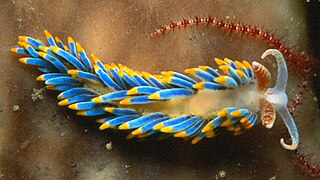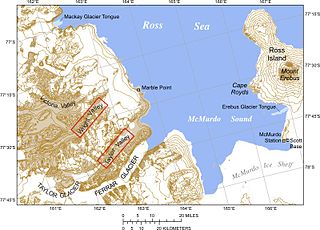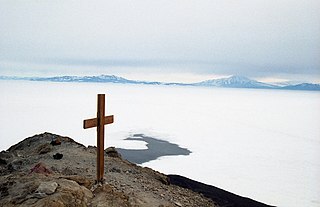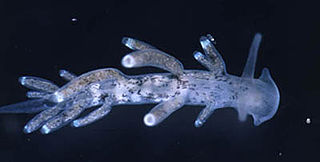
Nudibranchs are a group of soft-bodied, marine gastropod molluscs which shed their shells after their larval stage. They are noted for their often extraordinary colours and striking forms, and they have been given colourful nicknames to match, such as "clown," "marigold," "splendid," "dancer," "dragon," or "sea rabbit." Currently, about 3,000 valid species of nudibranchs are known.

McMurdo Sound and its ice-clogged waters extends about 55 kilometres (34 mi) long and wide. The sound connects the Ross Sea to the north with the Ross Ice Shelf cavity to the south via Haskell Strait. The strait is largely covered by the McMurdo Ice Shelf. The Royal Society Range rises from sea level to 4,205 metres (13,796 ft) on the western shoreline. Ross Island, an historic jumping-off point for polar explorers, designates the eastern boundary. The active volcano Mount Erebus at 3,794 metres (12,448 ft) dominates Ross Island. Antarctica's largest scientific base, the United States' McMurdo Station, as well as the New Zealand Scott Base are on the southern shore of the island. Less than 10 percent of McMurdo Sound's shoreline is free of ice. It is the southernmost navigable body of water in the world.

Observation Hill is a steep 754-foot (230 m) hill adjacent to McMurdo Station in Antarctica and commonly called "Ob Hill." It is frequently climbed to get good viewing points across the continent. Regular clear skies give excellent visibility.

Glaucus atlanticus is a species of small, blue sea slug, a pelagic aeolid nudibranch, a shell-less gastropod mollusk in the family Glaucidae.

An ice pier is a man-made structure used to assist the unloading of ships in Antarctica. It is constructed by pumping seawater into a contained area and allowing the water to freeze. By repeating this procedure several times, additional layers are built up. The final structure is many metres in thickness, and strong enough to support container trucks. Operation Deep Freeze personnel constructed the first floating ice pier at Antarctica’s southernmost sea port at McMurdo Station in 1973. Ice piers have been in use each summer season since, at McMurdo's natural harbor at Winter Quarters Bay located at 77°50′S166°40′E. The harbor is positioned on the southern tip of Ross Island.

Winter Quarters Bay is a small cove of McMurdo Sound, Antarctica, located 2,200 miles (3,500 km) due south of New Zealand at 77°50'S. The harbor is the southernmost port in the Southern Ocean and features a floating ice pier for summer cargo operations. The bay is approximately 250m wide and long, with a maximum depth of 33m. The name Winter Quarters Bay refers to Robert Falcon Scott's National Antarctic Discovery Expedition (1901–04) which wintered at the site for two seasons.
Cuthona is a genus of nudibranch in the family Tergipedidae.

Tenellia is a genus of sea slugs, aeolid nudibranchs, marine gastropod mollusks in the family Trinchesiidae.
Keys Point is a projecting point of land at McDonald Beach, 1 nautical mile (2 km) northwest of Inclusion Hill in northwestern Ross Island, Antarctica. At the suggestion of P.R. Kyle, it was named by the Advisory Committee on Antarctic Names after John R. Keys, a New Zealand geochemist who worked for several seasons during the 1970s and 1980s under the auspices of the New Zealand Antarctic Programme and the United States Antarctic Research Program on investigations as to the origin of salts in the McMurdo Sound area, the Mount Erebus volcano, and the quantity, shapes, and sizes of icebergs in the Antarctic marine environment.
Cadlina affinis is a species of sea slug or dorid nudibranch, a marine gastropod mollusk in the family Cadlinidae.
Tenellia crinita is a species of sea slug, an aeolid nudibranch, a marine gastropod mollusc in the family Fionidae.
Cuthonella elioti is a species of sea slug, an aeolid nudibranch, a marine gastropod mollusc in the family Cuthonellidae. It is a replacement name for Cuthonella antarctica Eliot, 1907.
Cuthonella modesta is a species of sea slug, an aeolid nudibranch, a marine gastropod mollusc in the family Cuthonellidae.
Cuthona paradoxa is a species of sea slug, an aeolid nudibranch, a marine gastropod mollusc in the family Tergipedidae.
Notaeolidia depressa is a species of sea slug, an aeolid nudibranch, a marine gastropod mollusc in the family Notaeolidiidae.
Notaeolidia gigas is a species of sea slug, an aeolid nudibranch, a marine gastropod mollusc in the family Notaeolidiidae.
Trinchesia macquariensis is a species of sea slug, an aeolid nudibranch, a marine gastropod mollusc in the family Trinchesiidae.

Pegasus Road is an 18-mile (29 km) long road of dirt and packed snow constructed by the United States Antarctic Program on Ross Island and the Ross Ice Shelf in Antarctica. The trip along the road from McMurdo Station to Pegasus Field takes approximately 45 minutes in a "Delta" wheeled vehicle, although on occasion high temperatures have damaged the runway and caused the road surface to deteriorate enough to lengthen the trip to two hours.
Eubranchus glacialis is a species of sea slug or nudibranch, a marine gastropod mollusc in the family Eubranchidae.

Phyllophora antarctica is a species of red alga in the family Phyllophoraceae. It is native to Antarctica where it grows in dim light on the underside of sea ice. Some of it becomes detached and accumulates in drifts on the seabed. Many different organisms live attached to the fronds or among them.








